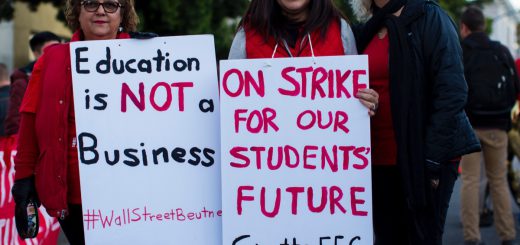Artists Need Unions, Too: The Role of Organized Labor in Creative Industries

Ken Green
CEO/Founder
UnionTrack, Inc.
Most people don’t often think of artists — this includes authors, actors and musicians — as workers with a reason to unionize. The glamour of those professions often shields the realities of working conditions for creative professionals, not only from the public, but from the artists themselves, too.
The truth of these professions is far less glamorous. Most creative professionals work in stressful, sometimes compromising conditions. And yet unions in these industries have grown at a slow pace.
It isn’t for lack of trying. It’s just that some industries have proven to be easier to unionize than others. Unions do exist for artists, but drawing individual workers into these unions has always been more challenging than in the trades.
Why It Is Difficult to Organize Artists Into Unions
Artist unions are up against a number of barriers in their efforts to grow their memberships.
The biggest challenge? Overcoming the mindset of artists who tend not to see themselves as workers within a collective group. Artists are naturally individualistic, explains British artist Patrick Brill, better-known as Bob and Roberta Smith. As such, they want to do their own thing, not “jump on other people’s bandwagons,” Smith says. That spirit of individualism makes it difficult to convince them to join together as a collective.
“Collective bargaining requires an obedient rank-and-file,” says jazz critic and music historian Ted Gioia. “But is there a profession more resistant to this than art-making?”
Furthermore, artists don’t always see the benefits of joining unions because they don’t define themselves as workers. Artists lack a traditional mode of employment that is often associated with unions, says Richard Whitby, a member of the Artists’ Union England. Most are self-employed artists who work remotely, not shop-floor employees who report to a boss. That makes it difficult for them to identify with unions and union membership.
Another key obstacle is the distributed nature of the various artistic professions. Locals by definition represent a centralized area where the union has a physical presence. The remote nature of work for painters, musicians, actors and other artists makes that model of organizing difficult to apply.
But it isn’t impossible. Most artistic professions have long had unions, or at the very least coalitions, to help them fight for better working conditions.

How Unions Can — And Do — Help Artists
Those in creative industries do need unions. They are workers because their art is the product of labor, argues Shaun Richman, program director for the Harry Van Arsdale Jr. Center for Labor Studies at New York Empire State College. But many artists are pressured to feel guilty about questioning their working conditions simply because they are doing something they love.
“If your job is reframed as a passion project, being dissatisfied with unfit labor conditions thus signals a personal failure: if you really loved your job, you wouldn’t care about being underpaid.” That’s how Athena Christa, a member of the Museum of Modern Arts Local 2110’s bargaining committee, describes the mentality of employers within the creative industries. When this is the attitude of the people writing the checks, it can be difficult to advocate for changes.
That’s why artists themselves have to drive change from the bottom up in order to improve their working conditions, says artist and author Nicolas Lampert. That collective bargaining power is how unions have done tremendous good for working artists.
Union Wins for Freelance Writers
The National Writers Union (NWU) stands up for writers who often work on a contract basis. It is not uncommon in the media industry for freelancers to go unpaid for long stretches, with little muscle to fight back against the big publishers. “The easiest thing to do is stiff the individual freelancer,” laments Larry Goldbetter, president of UAW Local 1981.
That’s when the NWU steps in and fights on the writer’s behalf. Some of its most recent noteworthy victories were against Ebony magazine and Nautilus magazine, settlements that netted $160,000 in back pay for 80 writers. In 2014, the union had a big victory against Heart and Soul magazine, where it won $125,000 for 12 freelancers.
These victories demonstrate the power of collective action — even when there is no centralized “workplace” to organize around.

Union Wins for Actors
The Screen Actors Guild-American Federation of Television and Radio Artists (SAG-AFTRA) works tirelessly to ensure actors and other workers in this industry receive fair pay and favorable working conditions.
Its 2017 contract with Alliance of Motion Picture and Television Producers included, for the first time, foreign residuals for when work is shown on affiliated platforms abroad. Depending on the work and how it’s distributed abroad, this provision can have a multiplying effect on an artist’s residual income. Casting director Marc Hirschfeld says this demonstrates SAG-AFTRA’s ability to fight on behalf of artists.
Another example: The 2019 contract between the Actors’ Equity Association and off-Broadway producers gives substantial salary increases to many actors and stage managers. The contract calls for wage increases of 32 to 81 percent over the life of the contract, and covers both commercial off-Broadway theatres and not-for-profits. Actors’ Equity President Kate Shindle called it a “historic” contract that allows actors and stage managers to do what they love while supporting themselves financially.
Union Wins for Musicians
The American Federation of Musicians (AFM) has a long history of wins for better working conditions for musicians. Some victories in recent years include:
- Securing yearly pay increases and a provision for extra income for members of the Philadelphia Orchestra if the orchestra meets fundraising and size expansion benchmarks.
- Signing a contract with music production company Confidential Music that allows movie trailer musicians to receive a payment when creating the music beds for trailers, then a second scale payment when the music is licensed into a trailer.
- Signing an agreement with another music production company, Hollywood Scoring, that allows for real-time audio and video streaming of entire demo sessions on the Internet, as well as new parameters for posting audio-only clips online for demo purposes.
In 2014, John Acosta, vice president of AFM Local 47, expressed his excitement about the broadening scope of the AFM. “This is definitely the direction that the Local and the AFM need to go in to expand the union’s presence in areas of the music industry where we don’t currently have density.”
UnionTrack ENGAGE is the perfect tool for artist unions and guilds to recruit new members, engage existing members and build a stronger base.
Images by: NejroN/©123rf.com, Igor Bulgarin/©123rf.com, undrey/©123rf.com







